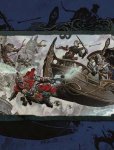Beoric
8, 8, I forget what is for
I think the thing about including DM-facing history is that it can help the DM present a consistent tone and to focus improvisation, so that even where the DM is ad libbing, hopefully the players can sense some kind of underlying logic or theme that makes the place feel real.
However, if hints at that history are also player-facing then the history does more than one job. In addition to helping the DM to be consistent, it can give the player a sense of discovery as historical elements are revealed. And it grants the player a sense of accomplishment as they start to form hypotheses about what was actually going on. And if those hypotheses allow the players to make better decisions or uncover hidden things, then they become actively related to the adventure content.
Because D&D isn't literature. Tolkein has to tell you or show you the mood-setting bits; literary characters coming to an epiphany because of what they discover does not scratch the same itch as D&D players coming to an epiphany, or putting that epiphany to use (unless the reader puts it together before the character, which can actually be a bit of a let-down). The active role of the player in D&D means that passively receiving information, however cool, may not be enough.
This does not mean you need to make a bee-line to the BBEG. Distractions are necessary, because in order to have a sense of accomplishment from progressing, it needs to be possible to not progress. And in Classic/OSR D&D, the DM doesn't necessarily know what the climax is going to be; the boss fight might be such a cakewalk that the players hardly mark it, while solving the puzzle of the well in that hidden room might be something that sticks with them for a long time. Because its the players who decide what constitutes "progress".
I also feel like, where possible, hidden areas should add to the vibe of the dungeon - that it part of the reward of finding them.
Also, @Malrex I totally get what you are saying about the "discomfort" vibe in PoUR.
However, if hints at that history are also player-facing then the history does more than one job. In addition to helping the DM to be consistent, it can give the player a sense of discovery as historical elements are revealed. And it grants the player a sense of accomplishment as they start to form hypotheses about what was actually going on. And if those hypotheses allow the players to make better decisions or uncover hidden things, then they become actively related to the adventure content.
Because D&D isn't literature. Tolkein has to tell you or show you the mood-setting bits; literary characters coming to an epiphany because of what they discover does not scratch the same itch as D&D players coming to an epiphany, or putting that epiphany to use (unless the reader puts it together before the character, which can actually be a bit of a let-down). The active role of the player in D&D means that passively receiving information, however cool, may not be enough.
This does not mean you need to make a bee-line to the BBEG. Distractions are necessary, because in order to have a sense of accomplishment from progressing, it needs to be possible to not progress. And in Classic/OSR D&D, the DM doesn't necessarily know what the climax is going to be; the boss fight might be such a cakewalk that the players hardly mark it, while solving the puzzle of the well in that hidden room might be something that sticks with them for a long time. Because its the players who decide what constitutes "progress".
I also feel like, where possible, hidden areas should add to the vibe of the dungeon - that it part of the reward of finding them.
Also, @Malrex I totally get what you are saying about the "discomfort" vibe in PoUR.







